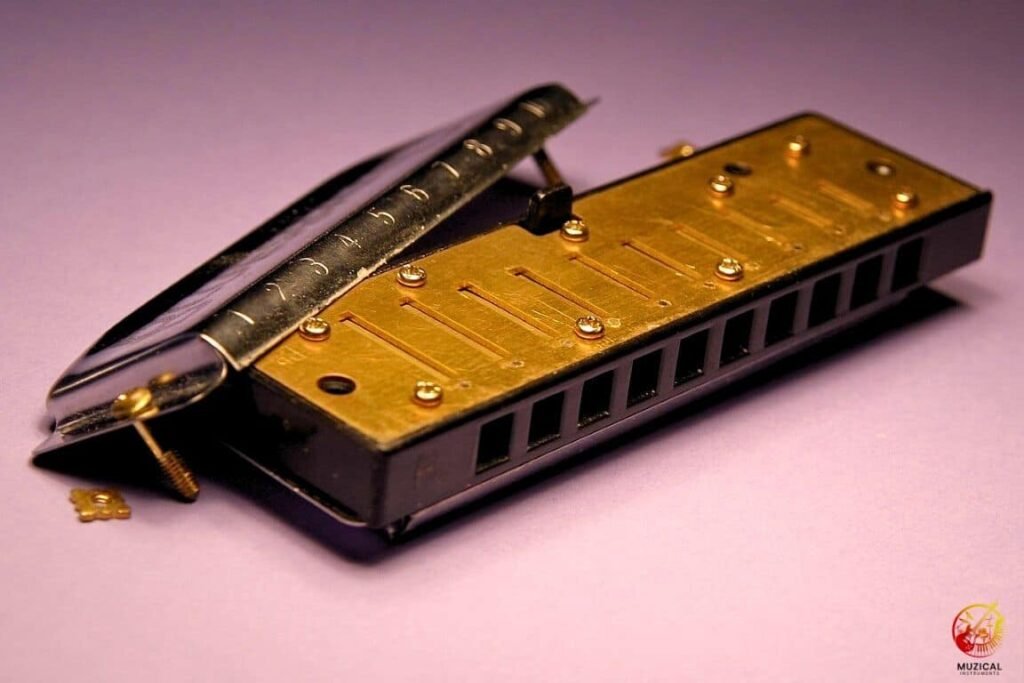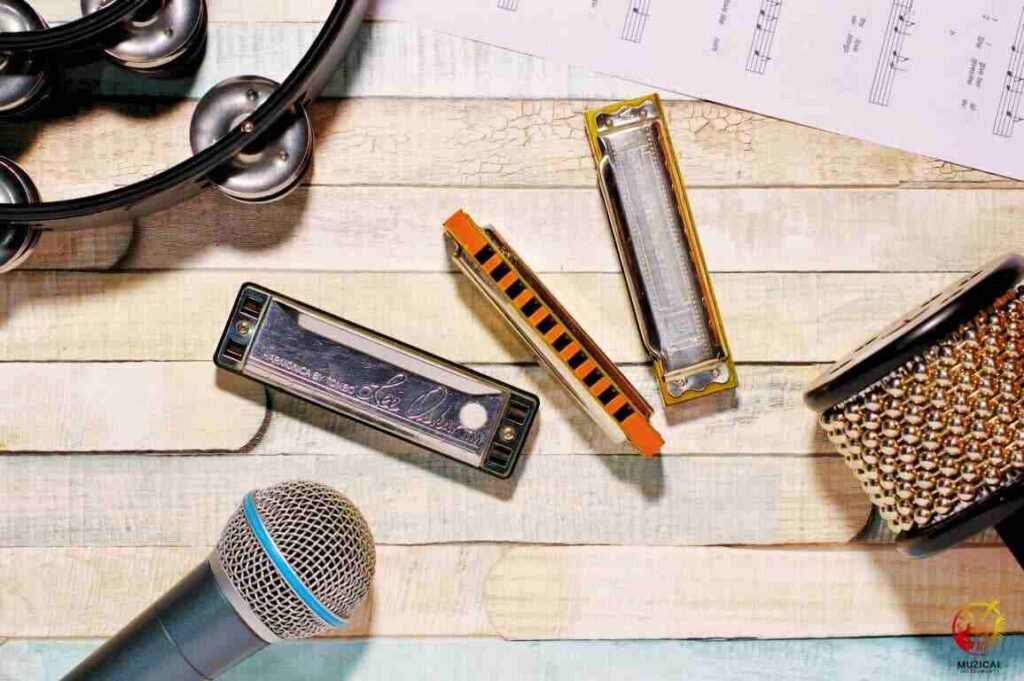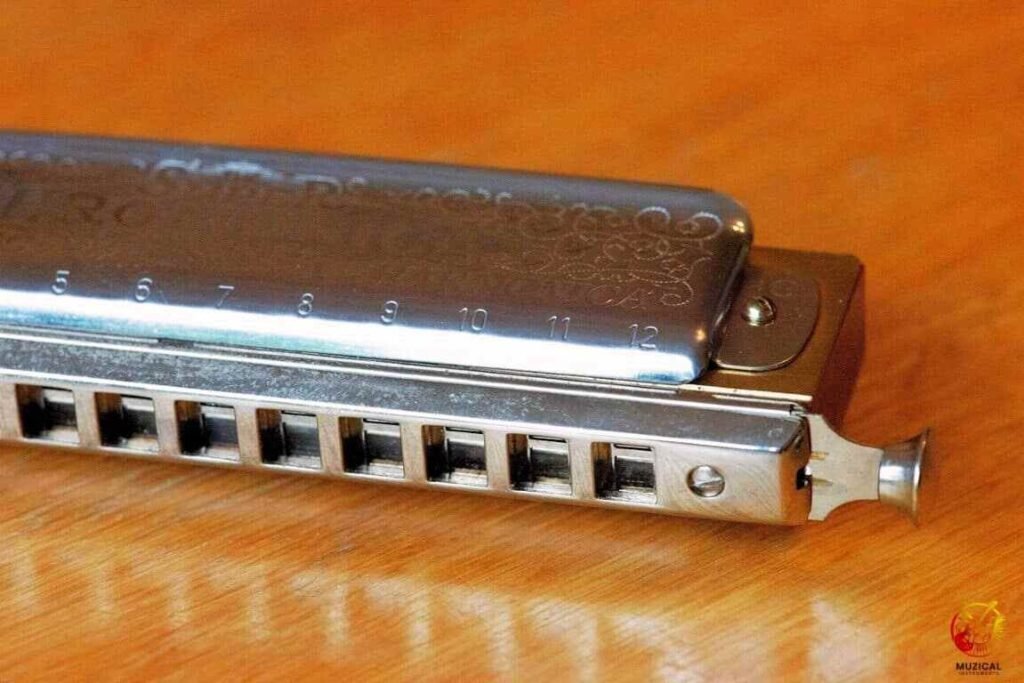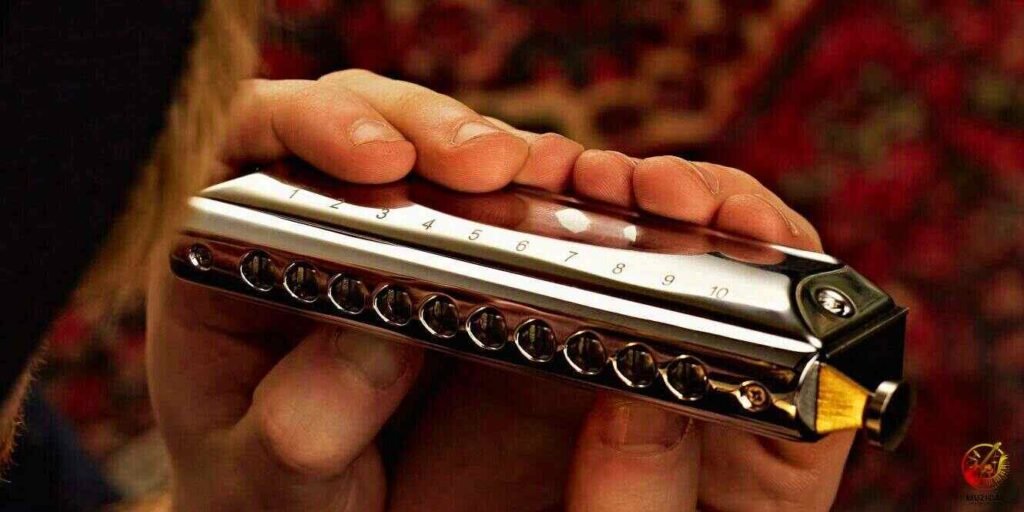Harmonica Reed Break-In Period: Myths vs Facts
The concept of a harmonica reed break-in period is one of the most talked about topics among harp players.
Many insist that playing a new harmonica gently for a while is key to its long life, much like breaking in a new car engine. However, the reality of reed mechanics tells a different story.
This article will pull back the curtain on the myths and give you the facts about this popular idea.
We’ll explore what really causes reeds to wear out, why your playing habits are more important than any special routine, and how you can make your harmonicas sound great and last longer from day one.
What Do People Mean by a “Harmonica Reed Break-In Period”?

When players discuss a harmonica reed break-in period, they’re talking about a process of “conditioning” the reeds on a new instrument. The usual advice is to play very softly for a few hours or even a few days, holding back on powerful notes and techniques like bending or overblowing.
The thinking is that this gentle start allows the metal in the reeds to “settle in,” preventing them from failing early and giving them a longer lifespan.
This idea probably started because players want to protect their investment. Nobody wants to spend good money on a new harp just to have a reed blow out. On the surface, the logic seems to make sense, we break in new shoes or car engines, so why not a harmonica?
Players often notice a new harp feels a bit stiff at first, but then “opens up” after some playing. They believe this is the result of a successful break-in.
However, this is a classic case of confusing two things that happen at the same time. While their harmonicas might last for years, it’s almost certainly because of their overall good playing technique (like playing with control and not too much force), not because of the initial ritual.
They are practicing good habits during the so called harmonica reed break-in period, and it’s these habits that are actually preserving the reeds.
Do New Harmonica Reeds Really Need to Be Broken In?

When you look at the actual metal of the reeds, the answer is a simple no. Harmonica reeds, usually made from brass, phosphor bronze, or stainless steel, don’t have a “memory” and can’t be “trained.”
The main reason a reed fails is due to something called metal fatigue, which builds up over time. Every single time a reed vibrates, it experiences a tiny amount of stress. This stress can eventually cause microscopic cracks that grow until the reed snaps.
Think about bending a paperclip back and forth. It doesn’t matter if your first few bends are slow and gentle; it’s the total number of bends that causes it to break. A harmonica reed is built to handle millions of vibrations. A gentle start doesn’t make the metal any stronger.
A well made reed is ready to be played correctly right out of the box. The factors that truly determine its life are the quality of the materials and, most importantly, how much force you use when you play.
Expert Insight: Top harmonica customizers like Joe Filisko and Richard Sleigh have been explaining for years that a well adjusted harmonica doesn’t need a break-in. If a harp feels stiff, it’s likely an issue with the reed gapping (the height of the reed from the plate), not a sign that it needs to be broken in.
So, why does a harp feel like it’s “opening up“? It’s not the reed metal changing. It’s more about tiny imperfections from the factory being smoothed out as you play. Even more significantly, you are learning the instrument. Your mouth shape and breath control are adjusting to that specific harmonica’s feel. The real “break-in” is happening with the player, not the instrument.
If Not Breaking In, What’s Actually Happening to a New Reed?

When you play a new harmonica for the first time, you aren’t changing the reed metal. You are simply starting the process of cumulative wear and tear that every reed goes through. The key isn’t a special harmonica reed break-in period, but playing in a way that doesn’t put too much stress on the reeds at any time.
Here’s what’s really going on:
- Reed Settling: A brand new reed might have tiny burrs from the manufacturing process that get smoothed out with initial playing. The reed also settles into its most efficient vibrating pattern in the slot. This is a minor, quick adjustment.
- You’re Learning the Harp: Every harmonica is a little different, even two of the same model from a brand like Hohner or Seydel. Your body and brain are great at making tiny adjustments. As you play, you naturally learn the right breath pressure and mouth shape (your embouchure) to make that specific instrument sound its best. This is why it feels more responsive, you’ve learned how to play it better.
- Reed Gapping is Key: The gap between the reed and the reed plate is crucial. If a harp feels hard to play, the gaps are likely too wide. If it chokes easily, they’re likely too narrow. Playing doesn’t fix the gaps, but a player might learn to use the exact amount of force needed to work with them, mistaking this learning process for breaking the harp in.
This table shows the difference between the myth and the reality.
| Mythical “Break-In” Belief | The Factual Reality |
|---|---|
| Playing softly “trains” the reed metal. | Metal can’t be trained. Playing gently just applies less stress, which is always a good thing. |
| The reed needs time to “settle” its structure. | The reed’s structure is fixed. The only settling is minor, as it finds its groove in the slot. |
| You must avoid bends for the first week. | Bending correctly is fine. Bending with too much force is what causes damage, on any day. |
| The harmonica “opens up” after being broken in. | The harmonica feels better because you have learned how to play it with more skill and efficiency. |
Why Does Playing Style Matter More Than a Harmonica Reed Break-in Period?

Your playing style is the number one thing that determines how long your harmonicas will last. The myth of the harmonica reed break-in period can unfortunately distract players from this simple truth.
A player with a forceful style can blow out a reed in days, while one with a relaxed, controlled technique can make the same harp last for years. Instead of a temporary ritual, players need to build good, lifelong habits.
Think of it like your voice: shouting all day will make you hoarse much faster than speaking normally. Reeds work the same way. They’re designed to respond to a smooth, steady stream of air, not a sudden blast.
Players who use brute force for volume or bends put huge stress on the base of the reed, which is its weakest point. This is where metal fatigue hits hardest and where reeds break.
Efficient players learn to use their whole airway, diaphragm, throat, and mouth to shape their sound. They get great tone and volume from resonance, not raw power. This relaxed approach uses far less air and puts much less strain on the reeds.
Key Habits for Long Reed Life:
- Breathe Deep: Use your diaphragm (the muscle below your lungs) to push air. It creates a steadier, more powerful stream than shallow chest breathing.
- Relax Your Mouth: A tight mouth and jaw choke off the airflow, forcing you to blow harder. Stay loose.
- Shape the Sound: Use the inside of your mouth like an echo chamber. Making shapes as if you’re saying “ee-oh-ah” can change the tone and volume without more air pressure.
- Bend with Skill, Not Force: A good bend comes from changing the shape of your mouth to guide the sound, not from trying to physically push the reed down with a blast of air.
What Is the Right Way to Warm Up a Harmonica Before Playing?
While a harmonica reed break-in period is a myth, warming up your harp before you play is a very real and useful practice. A proper warm up is often confused with a break-in, but its purpose is completely different.
The goal is simply to bring the instrument’s temperature up to match your breath. This prevents two main problems: moisture buildup and tuning issues.
When your warm, moist breath hits a cold metal harmonica, water condenses on the reeds. This can make them feel sticky or respond poorly. It also affects tuning, as reeds are tuned at room temperature. Warming the harp up first ensures it plays in tune and feels responsive from the first note.
A Simple and Effective Warm Up
Forget anything complicated. This takes less than a minute.
| Step | Action | Why It Matters |
|---|---|---|
| 1. Hold It | Simply hold the harmonica in your closed hands or keep it in a pocket for a few minutes. | Your body heat gently and evenly warms the entire instrument. |
| 2. Breathe Through It | Without playing notes, gently breathe warm air through the holes, moving back and forth. | This equalizes the temperature of the internal parts with your breath. |
| 3. Play Gently | Play some quiet single notes and easy scales up and down the harp. | This gets the reeds moving and lets you feel if any are sticking before you start playing hard. |
Pro Tip: Never use a heater or hairdryer to warm up a harmonica. Quick, intense heat can warp the comb (especially wooden ones) and damage the instrument. Slow and gentle is always the right way.
Final Thoughts
The harmonica reed break-in period is a myth, born from good intentions but based on a misunderstanding of how reeds work. While playing gently is never bad advice, the belief that it “conditions” a new instrument is incorrect. The long term health of your reeds is not decided in the first week of playing; it’s determined by your playing technique every time you pick up the instrument.
To sum it up:
- Reeds Don’t “Learn”: Metal doesn’t have a memory. A reed’s life is based on its quality and how much stress it’s put under.
- Technique Is King: A relaxed, efficient playing style is the best way to make your reeds last.
- Warm-Ups Are Real, Break-Ins Are Not: Warming your harp is a practical step for better tuning and response. It has nothing to do with the myth of the harmonica reed break-in period.
So, stop worrying about breaking in your harmonicas and start focusing on your playing. Listen to yourself. Are you using more force than you need?
By focusing on playing with skill instead of power, you’ll become a better musician and a happier harmonica owner.
The next time you get a new harp, you’ll know exactly what to do: play it correctly from the very first note.
FAQ: Harmonica Reed Break-In Period
1. Do harmonica reeds need a break-in period?
Not really. Most players and experts agree there’s no scientific break-in period for reeds. Hohner recommends gentle first use mostly to help you adapt and warm up the instrument not because the reeds themselves need breaking in.
2. What does gentle playing of a new harmonica do?
Gentle playing helps you get to know your new harp and lets the reeds warm to body temperature. Hohner suggests this helps you ease into correct playing stance and tone, not physically adjust the reeds.
3. Can break-in make reeds more flexible?
No, reeds don’t get more flexible from a break-in. If you play gently and avoid aggressive bending, your harmonica simply lasts longer. Reeds don’t change in flexibility through this process.
4. Why might some players feel reeds loosen up over time?
That sensation is often just you getting comfortable with the harp your technique improves, so it feels smoother. There may also be small deposits from breath moisture that help airtightness, though that’s more feel than fundamental break-in.
5. Should I soak my harmonica to break it in faster?
Absolutely not. Soaking may damage wooden combs or valves, affect tuning, or even void your warranty.
6. Does a new harmonica really “break in” like a car engine?
No. Unlike machines that need wear-in, a harmonica’s reeds are already functional out of the box. Any initial differences are more about your familiarity than the instrument changing.
